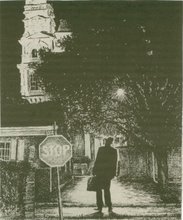After Labor Day the whole town seemed different. Most of the summer people had left. Living down the Cut, we’d still run into a few tourists along the Boulevard in mid-September—“stragglers,” everyone called them.
They’d be snapping pictures with their “Brownie” box cameras. Or they’d be getting their own pictures taken by Louis Bland, who held onto his post in the circle in front of the fisherman’s monument until the days grew cold and the rains washed down Stacy Promenade and the wind blew the leaves out of all the trees along
Louis would take your picture—it couldn’t have cost more than a quarter in those days—and the most fun would be watching him develop it right there, dipping the print into a little tank of chemicals, washing it off (you could smell the “hypo”), and handing to you in a stiff gray cardboard “Souvenir of Gloucester” frame.
How many of us have had our childhoods recorded in a series of images by
Still, you always knew when summer was over. The days felt different. And the light was different, too, as it had been since the last few weeks in August: more oblique in the morning, sharper; falling earlier in the evening, the trees casting long shadows at suppertime when you’d limp in after scrimmage along the river bank. No more baseball, once the football season had started; only the World Series on radio.
Of course, school was just around the corner, if it hadn’t already started. During the last week of August there would be the annual ritual of shopping for school clothes. Your mother would drag you around Brown's or the Empire, or in and out of Goldman’s or Grants. If you refused to make those obligatory trips, you’d probably end up with clothes you didn’t like—shirts, for example, the color and style of which you wouldn’t be caught dead in at Central Grammar.
So it was best to submit to the ordeal of trying on slacks that had to be cuffed, or the embarrassment of seeing yourself with those droopy trousers in several views in the big mirror of the men’s department in the Empire with the rest of the customers looking on. Henry Weiner sold me my first pair of long pants there, and I’ll always be grateful that he didn’t patronize me because I was a kid. Later, in high school, when you had the freedom of buying your own clothes, you could also go to Bloomberg’s or Alper’s for your back-to-school wardrobe. Their men's fashions were more up to date.
After we’d moved from the Cut to Rocky Neck in 1951, Labor Day was a more dramatic event. The number of customers in our store and in all the shops and restaurants on Rocky Neck would decrease markedly. You could tell the difference the day after Labor Day. The Neck would literally be deserted. Slowly all Dad’s “regulars”—Richard Hunt, Stan Farrell, Tommy Morse, Bill Sibley, Joe Garland, Jerry Hill, Harry Wheeler, Walter Kidder and Parker Morong—would reappear to take up their old stools at the counter for those long fall and winter nights of coffee and talk. Come winter, Dad closed early and we actually got a chance to sit down and talk together as a family before my brother and I went to bed early on school nights.
Summer ended precipitously in



